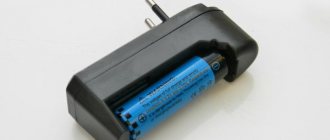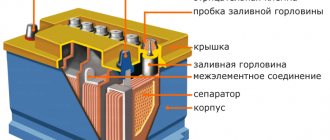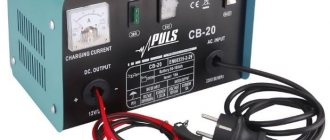An uninterruptible (backup) power supply (UPS) performs two important functions. Firstly, it stabilizes fluctuations in the mains voltage and, secondly, when the mains is disconnected (loss) it continues to provide the consumer with power from the battery. This transition is carried out automatically. Figure 1 shows an example of battery placement inside a medium power UPS.
The characteristics of the battery determine the power and duration of operation of the uninterruptible power supply. When the UPS operates when there is a network, the battery is in a gentle mode (on recharging) until the mains power disappears. After the warranty period expires or due to other unforeseen circumstances, it will need to be restored before being replaced with a new one. Let's look at how you can charge a battery from a UPS from various DC sources.
What batteries are suitable for UPS?
The rules for charging battery modules are directly dictated by the type of batteries used. All modern power supplies use lead-acid batteries. That is, the question of how to charge a UPS battery implies the process of charging lead-acid batteries. These batteries are similar to car batteries, but there are significant differences between them. For the most part, it is justified by the fact that in cars the battery is constantly blown by air passing under the hood. UPS batteries are static and motionless.
Before charging the battery from a UPS, it is worth understanding the structure and operating principle of batteries. The electrolyte inside the battery is contained in the form of a gel, so it does not spill or splash. Thanks to this, some UPS models can be installed both vertically and horizontally (for example, under a monitor). The battery is sealed and therefore does not require special user care, with the exception of timely charging of the uninterruptible power supply if necessary. Moreover, the UPS battery does not emit hydrogen or other explosive and harmful gases during operation, as it is recirculated in the housing space.
What kind of batteries are used in uninterruptible power supplies?
The UPS uses sealed (maintenance-free), mainly 12-volt batteries with a capacity of 5 to 250 Ah with output terminals (knife) Faston 187/250 (F2). The UPS uses the following types of batteries;
- with AGM technology;
- gel batteries.
- nickel-cadmium.
Batteries for UPS are produced by brands such as;
- IPPON - UK;
- Delta - China;
- Energy - Russia;
- CSB - Taiwan;
- BB Battery - Hong Kong;
- Fiamm - Italy;
- Leoch - China;
- C&D Technologies - USA;
- Yuasa - Japan;
- Sonnenschein - Germany;
- SVEN - China;
- Tudor - Portugal.
All UPS battery models are sealed and maintenance-free. The body material used is ABS (acrylonitrile butadiene styrene) plastic, which is resistant to mechanical and chemical influences and is a non-flammable material. The batteries for the UPS are located both inside the UPS and outside, depending on the power of the UPS. One of the common battery sizes for internal installation in a UPS is 151x65x94 (mm). Table 1 shows battery dimensions depending on capacity.
With a high output power of the UPS, high-capacity batteries are required, up to 250 Ah. Given their size and weight, they are installed externally. Table 2 shows the characteristics of some batteries for high-capacity sources.
| Picture | Name | Weight, kg) | Manufacturer country | Capacity (A/h) | Dimensions (mm) | Voltage | Type |
| SB HRL 12280W | 28,50 | Taiwan | 70 | 261x168x210 | 12 | AGM | |
| Delta HRL 12-100 | 33 | China | 100 | 330x171x215 | 12 | AGM | |
| LogicPower SILVER LP-MG 12-250 | 69 | Ukraine | 250 | 522x268x220 | 12 | AGM | |
| Fiamm 12FGL150 | 46.2 | Italy | 150 | 483x171x220 | 12 | AGM |
Table 2. Characteristics of powerful batteries.
Before the end of the warranty period of the battery or when the uninterruptible power supply begins to malfunction, it is necessary to check its energy capacity, which shows the ability to discharge in constant power mode for a short time (up to 15 minutes).
The UPS design provides for independent battery replacement. When replacing, you must take precautions when working with batteries. To maintain the performance characteristics of the UPS, the same type of drive (type and capacity) must be used when replacing.
Charging the UPS battery for the first time: what you need to know
When purchasing an uninterruptible power supply, it is important to understand how to initially charge the battery in the UPS. As a rule, during the time from the moment the equipment is manufactured until it is purchased and put into operation by the user, the factory charge of the battery is discharged. That is, the new UPS will arrive at your home, office or business in a discharged state. This means that the batteries will not be able to reliably maintain power to the protected devices when an uninterruptible power supply is immediately installed under the load. In addition, the device is programmed to perform self-tests before each start-up. The self-test procedure will end with a message indicating that the battery module is faulty and requiring its replacement.
Battery behavior when charging
We have described the ideal process in the case when the battery is more or less serviceable. However, more often than not, this does not happen. During operation, the battery's internal resistance increases and its capacity decreases.
A battery with an abnormally increased internal resistance will not be able to operate in a UPS, although it can be charged to the required voltage.
The increase in resistance is most likely due to degradation of the surface of the plates and changes in their chemical composition, so the process of restoring the battery is, in a sense, a lottery. On the other hand, a “hopeless” battery has a chance of recovery.
In my practice, there have been cases when batteries that had run down to 0.5 - 1 V and had been standing for many months were able to be charged to working condition. This was most likely facilitated by distilled water, which changed the chemical environment inside the battery.
In cases of a severely discharged battery, the initial charge current can be several milliamps. Based on the dynamics of charging current growth, we can make a preliminary forecast and prospects for battery recovery.
If it rises to 0.5 - 0.7 A within a few hours, the prospects are good. If the current has increased to several units or tens of mA, and does not increase further, there is little chance of recovery. However, even in this case it is worth fighting.
After several hours of charging, a discharge is needed. It is good to use a 40-80 W car lamp for this.
After several minutes of discharge, you should put the battery on charge and check the charging current. If it has increased from the original purpose and continues to grow, this is a good sign. You can do two or three charge-discharge cycles, controlling the charge current and voltage on the battery. The charge duration can be 1-2-4 hours, discharge 5 - 10 minutes.
If the battery takes a charge and is charging, you should load it with a car lamp and look at its glow. Based on the brightness and duration of the lamp, you can make a preliminary conclusion about the condition of the battery.
If, when connecting a lamp, the voltage at its terminals noticeably sags (and the lamp does not glow at full intensity), this indicates an increased internal resistance of the battery.
In this case, it is impossible to use it in a UPS.
I tried to reduce the internal resistance of the batteries by adding an additional amount (2-3 ml to each jar) of distilled water. But in no case was the attempt successful. True, I did not control the magnitude of this resistance. But I came to the following conclusion: if the battery cannot work normally in a UPS, adding an additional volume of distilled water will not help the situation.
There may be cases where there is increased internal resistance in one bank. There was a case when, after several minutes of discharge by a lamp, the outer surface of the battery heated up locally in a certain place. In the jar where the external battery terminal was.
Adding water to this particular jar did not help the situation either.
How to charge a UPS for a computer or other equipment after purchase:
- Connect the UPS to the network without connecting the load. The first charging of the UPS will require more time than subsequent normal charging procedures. Leave the uninterruptible power supply connected to the network for a day - 24 hours.
- Charging will occur when the UPS is powered from the mains, regardless of whether the device is turned on.
- In winter, before charging the UPS, after bringing it in from the cold, it is advisable to leave it in a warm room for several hours to warm it up.
After the first charging cycle, it is worth turning on the load to discharge the battery for the first time. A static load with constant, non-jumping power is preferred. After such a complete discharge, it is worthwhile to completely carry out the battery charge-discharge cycle again. Fully charge the UPS battery again - and after that it will be calibrated and ready to protect your equipment from power surges.
Rules for first charging and further use
For reliable operation of the battery during the warranty period, the manufacturer indicates restrictive data on the label;
- Rechargeable - rechargeable.
- Do not recharge - do not recharge (not charging).
- Initial current ХХ.Х А — charging current (no more).
- Floating (Standby) use XX V. - the maximum voltage at which the battery can remain for a long time (buffer mode).
- Cycle use - maximum voltage in cyclic mode (charge-discharge).
- Risk of fire, explosion, or burns - risk (danger) of fire, explosion or burn.
- Do not short circuit the battery - do not short-circuit the battery.
- Do not disassemble, heat above 40 °C or incinerate - do not disassemble, heat above 40 °C or burn.
- Recharge after use - recharge after use.
Figure 2 shows an example of a label (stencil) on a UPS battery.
The operating mode indicated on the case of your drive must be maintained at all times. A working uninterruptible power supply supports this mode. To check the functionality of the UPS battery charger, you need to disassemble the unit and use a multimeter to measure the voltage at the battery terminals (without disconnecting from the network). It should be (Floating use) 13–14 V. If it is less, then most likely the charging control circuit of the unit is faulty and it was not charging. Let's look at how to properly charge it yourself and check its performance.
Before installing a new battery, it must be recharged (several hours), as it loses charge during storage (from the date of manufacture to the date of sale). If the charge is lost by 25%, the battery must be recharged with a simple charger with a voltage of no more than 14 V, and in case of a deeper discharge (battery voltage below 10 V), automatic (smart) chargers with three charging stages must be used. The voltage at the terminals is measured with a multimeter.
Important. All switching must be done with the mains voltage turned off.
Before using a new battery, it is necessary to carry out a control and training cycle for the battery (discharge-charge). For this it is necessary;
- Install, secure and connect the battery (red +, black -).
- Disconnect the load from the UPS.
- Turn on the uninterruptible power supply to the network. Further restoration of the capacity will be carried out in normal mode, by the internal UPS circuit under the control of the controller.
- Turn off the UPS after a few hours (up to 24 hours).
- Connect the load to the UPS. You can turn on an equivalent load - an electric light bulb, an electric stove, etc., but the power is not greater than the power of the UPS.
- Disconnect from the network and turn on the UPS. When the storage is low, the UPS will shut down and the green indicator will flash and beep rapidly.
- Repeat the cycle 2 or 3 times.
- If there are no failures, connect the standard load, and you can use the device.
Basic rules for charging lead-acid batteries
To know how to charge a UPS correctly, it is enough to know only two rules for charging lead-acid batteries:
- The initial recharging current at its nominal value in Amperes should not be more than 3-30% of the capacity of the battery itself in Ampere-hours.
- Make sure the charger voltage matches your battery specifications.
In order for an expensive UPS battery to last its maximum service life without failures or loss of efficiency, the recharging current should be slightly less than recommended.
You can calculate how much to charge your uninterruptible power supply yourself. To do this, divide the battery capacity in Amp-hours by the current in the charger in Amp.
FAQ
Should I warm up the device before recharging if I brought it home from the street in winter ? - Yes, it is possible, and even necessary!
Do I need to turn it on when charging ? - No, it’s not at all necessary.
Can it be charged with a car charger ? - Yes. The peculiarity in this case is that the UPS battery should be charged for about a day with a low current. The current should be 0.1 of the battery capacity. To do this, the battery is removed from the UPS, and the charging wires are connected to its terminals, observing the polarity. You can “remove” the jars from the caps. When charging, carefully monitor the current level on the ammeter. It will be useful to watch the following video
How often should I charge the UPS battery?
How often and with what should UPS batteries be charged so that it lasts as long as possible? The longest permissible service life of an uninterruptible power supply is achievable if the battery of the uninterruptible power supply is charged continuously from one charger with the same voltage: either constant or floating voltage. The period of simple storage is usually less than the actual life of a constantly used and recharged battery. Therefore, you should not be afraid of premature wear of the UPS battery due to frequent charging. On the contrary, some of the natural processes of wear and tear and aging of devices are slowed down and stopped by constantly recharging the battery.
When purchasing power supplies from specialized companies, employees will explain in detail how to charge the UPS, what the operating conditions are and other specific features of the equipment. By following the recommendations of professionals, you will protect your equipment from premature wear and tear, and you will protect yourself from excessive spending on repairs and replacement of equipment elements.
Preliminary preparation for battery restoration
The first step is to fill the battery with a small amount of distilled water. A 12-volt battery has 6 series-connected jars, each of which produces a voltage of about 2 V. 3 milliliters of distilled water must be poured into each jar.
In this case, it is convenient to use a medical syringe with a volume of 10-20 “cubes” with divisions. To gain access to the banks, you need to open either the common cover on the side of the terminals or the round covers opposite each bank. It is convenient to use a screwdriver with a thin narrow blade.
It is necessary to insert the screwdriver blade into the corresponding recesses and pry off the cap. After restoration is complete, it can be glued with quick-drying “cyanopane” glue or similar.
After the lids are removed, you also need to remove the rubber stoppers that seal the openings of the cans.
Cans should be kept open during charging!
Before pouring water, you need to carefully look inside the jars. In some batteries, the can outlet is covered with a transparent film. If it is there, you need to carefully pierce it with a thin awl.
This should be done carefully so as not to damage the battery plates.
When pouring water, do not insert the syringe needle too deeply, otherwise its outlet hole will become clogged with grease from the plates. After the water is poured in, you should wait a couple of hours so that it is distributed in the space of the cans.
Battery THEORY. Required for studying!
Here I will only touch on the theory of MAINTAINED lead-acid starter batteries used in cars and produced in compliance with all technological production standards (in other words, not produced in the Chinese basement of Uncle Liao or in the janitor's room of the former house of Ippolit Matveevich in Stargorod). They are the cheapest but at the same time the most “knowledge-intensive” to operate.
If they are used and maintained correctly, but most importantly, charged correctly, they can last more than 15 years, or withstand more than FOUR HUNDRED 100% discharge-charge cycles or more than a THOUSAND 30-40% discharge-charge cycles! It's been tested, I guarantee!
An example of converting a UPS to a car battery
Reader BoB4uk took the advice outlined in the article and assembled a similar device. More details in the comments around March 17, 2022.
UPS panel in different modes
Reworked diagram by the author











